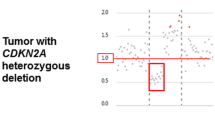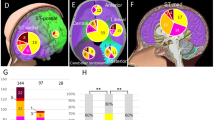Abstract
Purpose
The molecular mechanisms and candidate genes involved in development of meningiomas still needs investigation and elucidation.
Methods
In the present study 60 meningiomas were analyzed regarding changes of tumor suppressor gene E-cadherin (CDH1), a component of adherens junction and an indirect modulator of the wnt signaling. Gene instability was tested by polymerase chain reaction/loss of heterozygosity (LOH) method. Protein expression was analyzed by immunohistochemistry.
Results
The results of our analysis showed altogether 32% of samples with LOH of the CDH1 gene. Interestingly, another type of genomic instability was detected; replication error-positive samples (RER+). Three out of 28 heterozygous samples were RER+ (11%). The instability is the result of impaired cellular mismatch repair. Fibrous and angiomatous cases showed higher percent of genetic changes, 67 and 75%, respectively. Immunostaining showed that overall 73% of samples had downregulation of E-cadherin expression. Intense downregulation of E-cadherin was noticed in tumors with grades II and III. Five out of nine samples with LOH were accompanied with the downregulation of E-cadherin protein expression (56%). One RER+ sample had lower expression of E-cadherin. We noticed that 36.4% of samples with lower E-cadherin expression had beta-catenin located in the nucleus. Also, 75% of samples with genomic instabilities had beta-catenin in the nucleus. Our findings demonstrated that there is significant association between the genetic changes of CDH1 and the nuclear localization of beta-catenin protein (χ2 = 5.25, df = 1, P < 0.022). Beta-catenin was progressively upregulated from meningothelial to atypical, while 60% of anaplastic showed upregulation and nuclear localization of the protein.
Conclusions
Our results suggest that genetic instabilities of the E-cadherin gene have a role in meningioma development and progression. Detected microsatellite instability indicates that mismatch repair may also be targeted in meningioma.



Similar content being viewed by others
References
Akat K, Bleck CK, Lee YM et al (2008) Characterization of a novel type of adherens junction in meningiomas and the derived cell line HBL-52. Cell Tissue Res 331:401–412
Brunner EC, Romeike BF, Jung M et al (2006) Altered expression of beta-catenin/E-cadherin in meningiomas. Histopathology 49:178–187
Ellison DW, Onilude OE, Lindsey JC, United Kingdom Children’s Cancer Study Group Brain Tumour Committee et al (2005) Beta-catenin status predicts a favorable outcome in childhood medulloblastoma: the United Kingdom Children’s Cancer Study Group Brain Tumour Committee. J Clin Oncol 23:7951–7957
Fogarty MP, Kessler JD, Wechsler-Reya RJ (2005) Morphing into cancer: the role of developmental signaling pathways in brain tumor formation. J Neurobiol 64:458–475
Fuller CE, Perry A (2005) Molecular diagnostics in central nervous system tumors. Adv Anat Pathol 12:180–194
Gordon MD, Nusse R (2006) Wnt signalling: multiple pathways, multiple receptors, and multiple transcription factors. J Biol Chem 281:22429–22433
Hall AC, Lucas FR, Salinas PC (2000) Axonal remodeling and synaptic differentiation in the cerebellum is regulated by WNT-7a signaling. Cell 100:525–535
Howng SL, Wu CH, Cheng TS et al (2002) Differential expression of Wnt genes, beta-catenin and E-cadherin in human brain tumors. Cancer Lett 183:95–101
Ionov Y, Peinado MA, Malkhosyan S et al (1993) Ubiquitous somatic mutations in simple repeated sequences reveal a new mechanism for colonic carcinogenesis. Nature 363:558–561
Kleihues P, Louis DN, Scheithauer BW et al (2002) The WHO classification of tumors of the nervous system. J Neuropathol Exp Neurol 61:215–225
Koch A, Waha A, Tonn JC et al (2001) Somatic mutations of WNT/wingless signaling pathway components in primitive neuroectodermal tumors. Int J Cancer 93:445–449
Li F, Chong ZZ, Maiese K (2006) Winding through the WNT pathway during cellular development and demise. Histol Histopathol 21:103–124
Lie DC, Colamarino SA, Song HJ et al (2005) Wnt signalling regulates adult hippocampal neurogenesis. Nature 437:1370–1375
Louis DN, Ohgaki H, Wiestler OD et al (2007) The 2007 WHO classification of tumours of the central nervous system. Acta Neuropathol 114:97–109
Nagashima G, Fujimoto T, Suzuki R et al (2006) Dural invasion of meningioma: a histological and immunohistochemical study. Brain Tumor Pathol 23:13–17
Panagopoulos AT, Lancellotti CL, Veiga JC et al (2008) Expression of cell adhesion proteins and proteins related to angiogenesis and fatty acid metabolism in benign, atypical, and anaplastic meningiomas. J Neurooncol 89:73–87
Patapoutian A, Reichardt LF (2000) Roles of wnt proteins in neural development maintenance. Curr Opin Neurobiol 10:392–399
Pećina-Šlaus N (2003) Tumor suppressor gene E-cadherin and its role in normal and malignant cells. Cancer Cell Int E3:17. http://www.cancerci.com/content/3/1/17
Pećina-Šlaus N, Gall-Trošelj K, Kapitanović S et al (2002) Novel alleles of the D16S752 polymorphic genetic marker linked to E-cadherin gene: a potential population marker. Coll Antropol 26:85–88
Pećina-Šlaus N, Nikuševa Martić T, Tomas D et al (2008) Meningiomas exhibit loss of heterozygosity of the APC gene. J Neurooncol 87:63–70
Perry A, Gutmann DH, Reifenberger G (2004) Molecular pathogenesis of meningiomas. J Neurooncol 70:183–202
Polakis P (2007) The many ways of Wnt in cancer. Curr Opin Genet Dev 17:45–51
Riemenschneider MJ, Perry A, Reifenberger G (2006) Histological classification and molecular genetics of meningiomas. Lancet Neurol 5:1045–1054
Schwechheimer K, Zhou L, Birchmeier W (1998) E-cadherin in human brain tumours: loss of immunoreactivity in malignant meningiomas. Virchows Arch 432:163–167
Shimamura K, Takeichi M (1992) Local and transient expression of E-cadherin involved in mouse embryonic brain morphogenesis. Development 116:1011–1019
Utsuki S, Oka H, Sato Y et al (2005) Invasive meningioma is associated with a low expression of E-cadherin and beta-catenin. Clin Neuropathol 24:8–12
Weber RG, Bostrom J, Wolter M et al (1997) Analysis of genomic alterations in benign, atypical, and anaplastic meningiomas: toward a genetic model of meningioma progression. Proc Natl Acad Sci USA 94:14719–14724
Wrobel G, Roerig P, Kokocinski F et al (2005) Microarray-based gene expression profiling of benign, atypical and anaplastic meningiomas identified novel genes associated with meningioma progression. Int J Cancer 114:249–256
Yu X, Malenka RC (2003) Beta-catenin is critical for dendritic morphogenesis. Nat Neurosci 6:1169–1177
Acknowledgements
This work was supported by grant 108-1081870-1905 from Ministry of Science Sports and Education, Republic of Croatia.
Conflict of interest statement
There is no conflict of interest.
Author information
Authors and Affiliations
Corresponding author
Rights and permissions
About this article
Cite this article
Pećina-Šlaus, N., Nikuševa Martić, T., Deak, A.J. et al. Genetic and protein changes of E-cadherin in meningiomas. J Cancer Res Clin Oncol 136, 695–702 (2010). https://doi.org/10.1007/s00432-009-0708-z
Received:
Accepted:
Published:
Issue Date:
DOI: https://doi.org/10.1007/s00432-009-0708-z




